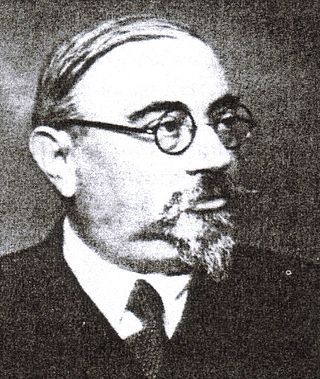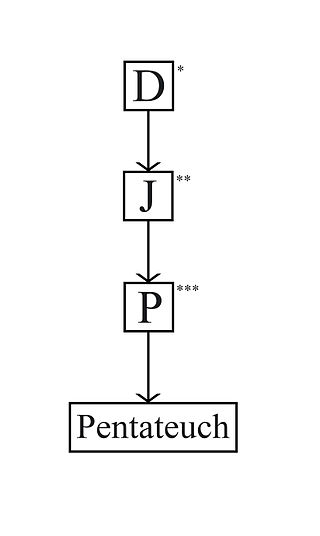The Book of Genesis is the first book of the Hebrew Bible and the Christian Old Testament. Its Hebrew name is the same as its first word, Bereshit. Genesis is an account of the creation of the world, the early history of humanity, and of Israel's ancestors and the origins of the Jewish people.

The documentary hypothesis (DH) is one of the models used by biblical scholars to explain the origins and composition of the Torah. A version of the documentary hypothesis, frequently identified with the German scholar Julius Wellhausen, was almost universally accepted for most of the 20th century. It posited that the Pentateuch is a compilation of four originally independent documents: the Jahwist (J), Elohist (E), Deuteronomist (D), and Priestly (P) sources. The first of these, J, was dated to the Solomonic period. E was dated somewhat later, in the 9th century BCE, and D was dated just before the reign of King Josiah, in the 7th or 8th century. Finally, P was generally dated to the time of Ezra in the 5th century BCE. The sources would have been joined together at various points in time by a series of editors or "redactors."
The historicity of the Bible is the question of the Bible's relationship to history—covering not just the Bible's acceptability as history but also the ability to understand the literary forms of biblical narrative. One can extend biblical historicity to the evaluation of whether or not the Christian New Testament is an accurate record of the historical Jesus and of the Apostolic Age. This tends to vary depending upon the opinion of the scholar.

Umberto Cassuto, also known as Moshe David Cassuto, was an Italian historian, a rabbi, and a scholar of the Hebrew Bible and Ugaritic literature, in the University of Florence, then at the University of Rome La Sapienza. When the 1938 anti-Semitic Italian racial laws forced him from this position, he moved to the Hebrew University of Jerusalem.
Martin Noth was a German scholar of the Hebrew Bible who specialized in the pre-Exilic history of the Hebrews and promoted the hypothesis that the Israelite tribes in the immediate period after the settlement in Canaan were organised as a group of twelve tribes arranged around a central sanctuary on the lines of the later Greek and Italian amphictyonies. With Gerhard von Rad he pioneered the traditional-historical approach to biblical studies, emphasising the role of oral traditions in the formation of the biblical texts.

According to the documentary hypothesis, the Elohist is one of four source documents underlying the Torah, together with the Jahwist, the Deuteronomist and the Priestly source. The Elohist is so named because of its pervasive use of the word Elohim to refer to the Israelite god.

The Jahwist, or Yahwist, often abbreviated J, is one of the most widely recognized sources of the Pentateuch (Torah), together with the Deuteronomist, the Priestly source and the Elohist. The existence of the Jahwist is somewhat controversial, with a number of scholars, especially in Europe, denying that it ever existed as a coherent independent document. Nevertheless, many scholars do assume its existence. The Jahwist is so named because of its characteristic use of the term Yahweh for God.

The Priestly source is perhaps the most widely recognized of the sources underlying the Torah. It is both stylistically and theologically distinct from other material in the Torah, and includes a set of claims that are contradicted by non-Priestly passages and therefore uniquely characteristic: no sacrifice before the institution is ordained by Yahweh (God) at Sinai, the exalted status of Aaron and the priesthood, and the use of the divine title El Shaddai before God reveals his name to Moses, to name a few. In general, the Priestly work is concerned with priestly matters – ritual law, the origins of shrines and rituals, and genealogies – all expressed in a formal, repetitive style. It stresses the rules and rituals of worship, and the crucial role of priests, expanding considerably on the role given to Aaron.
The patriarchal age is the era of the three biblical patriarchs, Abraham, Isaac and Jacob, according to the narratives of Genesis 12–50. It is preceded in the Bible by the primeval history and followed by The Exodus.

Form criticism as a method of biblical criticism classifies units of scripture by literary pattern and then attempts to trace each type to its period of oral transmission. "Form criticism is the endeavor to get behind the written sources of the Bible to the period of oral tradition, and to isolate the oral forms that went into the written sources. Insofar as this attempts to trace the history of the tradition, it is known as tradition criticism." Form criticism seeks to determine a unit's original form and the historical context of the literary tradition.
John Van Seters is a Canadian scholar of the Hebrew Bible and the Ancient Near East. Currently University Distinguished Professor Emeritus at the University of North Carolina, he was formerly James A. Gray Professor of Biblical Literature at UNC. He took his Ph.D. at Yale University in Near Eastern Studies (1965) and a Th.D. h.c. from the University of Lausanne (1999). His honours and awards include a Guggenheim Fellowship, an NEH fellowship, an ACLS Fellowship, and research fellowships at Oxford, Cambridge, Katholieke Universiteit Leuven, and National Research Foundation of South Africa. His many publications include The Hyksos: A New Investigation (1966); Abraham in History and Tradition (1975); In Search of History ; The Edited Bible (2006); and The Biblical Saga of King David (2009).
The Covenant Code, or Book of the Covenant, is the name given by academics to a text appearing in the Torah, at Exodus 20:22–23:19; or, more strictly, the term Covenant Code may be applied to Exodus 21:1–22:16. Biblically, the text is the second of the law codes given to Moses by God at Mount Sinai. This legal text provides a small but substantive proportion of the mitzvot within the Torah, and hence is a source of Jewish Law.
The Wiseman hypothesis, sometimes called the tablet theory, is a theory of the authorship and composition of the Book of Genesis which suggests that Moses compiled Genesis from tablets handed down through Abraham and the other patriarchs. Originally advocated by P. J. Wiseman (1888–1948) in his New discoveries in Babylonia about Genesis (1936) and republished by Wiseman's son, Donald Wiseman, as Ancient records and the structure of Genesis: A case for literary unity in 1985, the hypothesis received some support from R. K. Harrison (1969) but otherwise remained without acceptance in scholarly circles.
Rolf Rendtorff was Emeritus Professor of Old Testament at the University of Heidelberg. He has written frequently on the Jewish scriptures and was notable chiefly for his contribution to the debate over the origins of the Pentateuch.
Prolegomena zur Geschichte Israels is a book by German biblical scholar and orientalist Julius Wellhausen (1844–1918) that formulated but did not found the documentary hypothesis, a theory on the composition history of the Torah or Pentateuch. Influential and long debated, the volume is often compared for its impact in its field with Charles Darwin's 1859 work, On the Origin of Species.
The Making of the Pentateuch by R. N. Whybray, Professor of Hebrew and Old Testament Studies at the University of Hull (UK), was a major contribution to the field of Old Testament studies, and specifically to theories on the origins and composition of the Pentateuch. Its originality lay in its detailed critique of the documentary hypothesis, and it remains a standard text on many reading lists.
Source criticism, in biblical criticism, refers to the attempt to establish the sources used by the authors and redactors of a biblical text. It originated in the 18th century with the work of Jean Astruc, who adapted the methods already developed for investigating the texts of classical antiquity to his own investigation into the sources of the Book of Genesis. It was subsequently considerably developed by German scholars in what was known as "the higher criticism", a term no longer in widespread use. The ultimate aim of these scholars was to reconstruct the history of the biblical text and also the religious history of ancient Israel.

In biblical studies, the supplementary hypothesis proposes that the Pentateuch was derived from a series of direct additions to an existing corpus of work. It serves as a revision to the earlier documentary hypothesis, which proposed that independent and complete narratives were later combined by redactors to create the Pentateuch.
Hans Heinrich Schmid was a Swiss Protestant Reformed theologian, University Professor and University Rector.
The composition of the Torah was a process that involved multiple authors over an extended period of time. While Jewish tradition holds that all five books were originally written by Moses sometime in the 2nd millennium BCE, leading scholars have rejected Mosaic authorship since the 17th century.




